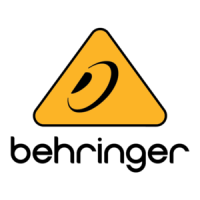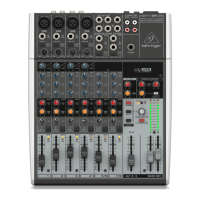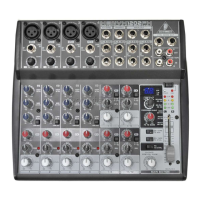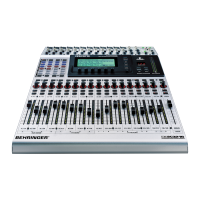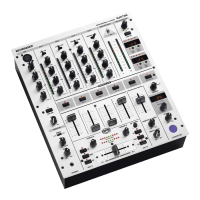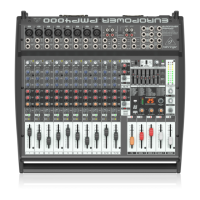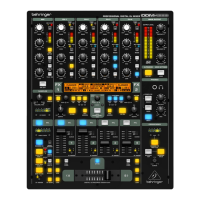14
B-CONTROL
DEEJAY
BCD3000
6. MIDI CONTROL
All control functions of the BCD3000 are sent to your computer
as MIDI data. The Musical Instruments Digital Interface is a generic,
non-manufacturer-specific standard that enables communication
between electronic musical instruments. Although the BCD3000
is not equipped with the “classic” 5-pin MIDI connectors, it still
uses the MIDI protocol for data transmission via USB. Thus, the
BCD3000 can also control third-party software, as long as it is
able to “speak” MIDI. In turn, the BCD3000 can receive MIDI data
and use them to show the switching status of the button LEDs.
Primarily, two MIDI data types are used: Control Change (CC no.)
and Note commands (Note no.). The CC commands allow values,
which change continuously, to be transmitted in real time. Button
functions are sent with Note commands. You can match the MIDI
commands to the software functions in the DJ software of your
choice. Please note that the different behaviors of the LED control
and the buttons’ Toggle On/Off mode depend on the selected
GLOBAL MODE, as explained in Chapter 4.2 under “The MIDI
Tab”.
6.1 Sending control change functions
All rotary knobs, faders, wheels and the crossfader are control
elements that send CC data. A CC number is assigned to each
control element; the transmitted absolute values range between
0 and 127. The Scratch wheels are the exception, owing to the
fact that continuous encoders do not transmit absolute values.
They send value changes (increment = +1, decrement = -1)
when used. The following table shows the regular assignment
of CC numbers categorized in function groups.
Rotary control functions:
Group Name
MIDI CC no.
LOW (EQ) 3
MID (EQ) 4
HIGH (EQ) 5
GAIN 6
LOW (EQ) 7
MID (EQ) 8
HIGH (EQ) 9
GAIN 10
Data 1 13
Data 2 14
Data 3 15
Data 4 16
OUTPUT PHONES MIX 17
DECK A
FX CONTROL
DECK B
Table 6.1: MIDI commands for transmitting rotary control
functions
Infinitely variable encoder functions:
Group Name
MIDI CC no
DECK A
SEARCH WHEEL
19*
DECK B
SEARCH WHEEL
18*
* The Scratch wheels only send +1/-1 impulses (Inc/Dec): left
turn value 63, right value 65. When the acceleration function is
activated (preset after switching on), the value change can also
be larger; this depends on the wheel’s speed when scrolled
manually (see Chapter 6.3).
Table 6.2: MIDI commands for transmitting infinitely variable
encoder functions
Fader functions:
Group Name
MIDI CC no
PITCH Fader 11
VOLUME Fader 0
DECK A<>B CROSS Fader 1
PITCH Fader 12
VOLUME Fader 2
DECK A
DECK B
Table 6.3: MIDI commands for transmitting fader functions
6.2 Sending button functions
All switching elements (buttons) of the BCD3000 transmit MIDI
note commands. When you press a button, the system sends a
“note on” command, together with the corresponding note
number. When the button is released, the system transmits a
“note off” command.
Press (and hold) a button = note on / release a button = note off.
(For a permanent note-on command, please select “toggle on”
in the software.)
Group Name
MIDI note
no.
MIDI note
name
SEARCH << 0 C -1
SEARCH >> 1 C# -1
BEND - 2 D -1
BEND + 3 D# -1
LOW KILL 12 C 0
MID KILL 13 C# 0
HIGH KILL 14 D 0
SET CUE 4 E -1
SET LOOP 15 D# 0
RELOOP 5 F -1
SYNC 16 E 0
SCRATCH 17 F 0
PLAY 18 F #0
CUE 19 G 0
SEARCH << 6 F# -1
SEARCH >> 7 G -1
BEND - 8 G# -1
BEND + 9 A -1
LOW KILL 20 G #0
MID KILL 21 A 0
HIGH KILL 22 A# 0
SET CUE 10 A# -1
SET LOOP 23 B 0
RELOOP 11 B -1
SYNC 24 C 1
SCRATCH 25 C# 1
PLAY 26 D 1
CUE 27 D# 1
EXT IN A 29 F 1
EXT IN B 30 F# 1
ON (FX unit active) 31 G 1
FX
(preset down) 32 G# 1
FX
(preset up)
33 A 1
ACTION (or TAP)
34 A# 1
CUE CUE A 35 B 1
SELECT CUE B 36 C 2
KEY DECK
A+B
KEY DECK A+B * 28 E 1
DECK A
DECK B
INPUT
SELECT
FX
CONTROL
* Activates the Time Stretch mode for Decks A+B simultaneously.
Table 6.4: MIDI commands for transmitting button functions
6. MIDI CONTROL
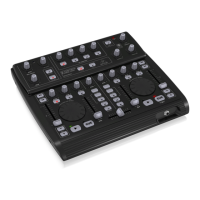
